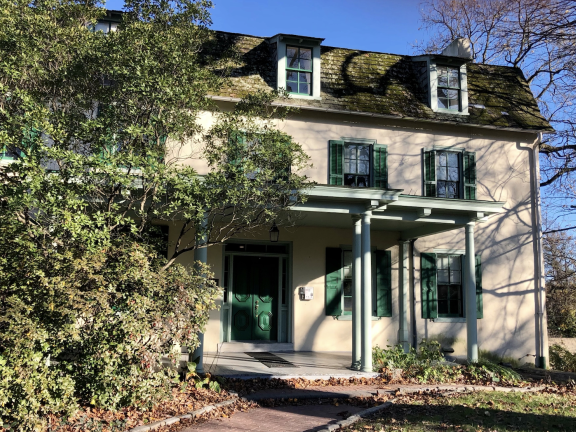Charles Wilson Peale House

This was the home of the painter Charles Willson Peale (1741-1827), whose many portraits define for us the appearance of the political and military leaders of the Revolutionary and early republican periods.
A brilliant polymath, Peale was trained as a saddle maker and tried his hand at clockmaking and metalwork before discovering that painting was his forte. He spent 1767-69 in London under the tutelage of Benjamin West. He returned to America and moved to Philadelphia in 1776, where he established a prosperous practice and opened a museum, America’s first, in which he displayed his large natural history, archaeological, and ethnographic collections along with his portraits. The museum expanded and moved to the statehouse (Independence Hall) in 1802.
In 1810, Peale turned the operation of the museum over to his son Rubens and moved to this house, which he purchased along with 104 acres of farmland. First called “Perseverance,” he changed the name to “Belfield” when friends suggested it needed a more optimistic title. The farmhouse had been built ca. 1755 by Conrad Weber, and Peale’s paintings of it show a gambrel roofed 3-bay building with a separate kitchen house. Peale added the two north bays and attached the kitchen to the main house; the present gambrel roof dates to about 1900.
At Belfield, Peale’s scientific and aesthetic interests were brought together. He laid out the gardens in a picturesque style, with fishponds, several gazebos, and a memorial obelisk, and he also devoted himself enthusiastically to scientific agriculture. He was a member of the Philadelphia Society for Promoting Agriculture, and he experimented with crops and livestock, equipped his farm with machinery of all sorts, and built a water-powered cotton mill. He advised his friend Thomas Jefferson that "your garden must be a museum to you"—suggesting that the farm was an extension of his downtown natural history exhibit.
In October 1821, Peale and his third wife Hannah contracted yellow fever, which led to Hannah's death. Peale moved back into Philadelphia, and in 1826 the industrialist William Logan Fisher bought this property, which passed down through his family (and the intermarried Wisters). La Salle University bought the house in 1984. Renamed Peale House, it served as the president’s residence until in 2018, when it became Alumni House.
Ref: James A. Butler, Charles Willson Peale's "Belfield": A History of a National Historic Landmark, 1684-1984 (Philadelphia: La Salle University Art Museum, 2009)
Photo credit: Secrets of Philadelphia